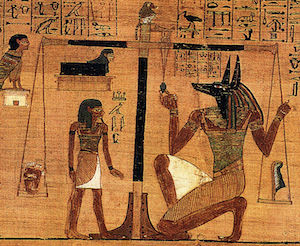

Shai (also written as Sai, or Shay, and Psais in Greek) was the personification of the concept of fate or destiny in ancient Egypt. His name means “that which is ordained” but is also related to the word “shay” meaning “extent” or “amount”. Although generally “fate” was deemed to be male, there was also a female version of this god known as “shait”.
The Egyptians believed that Shai determined the length of each person’s life and was born with each person at their birth and remained at their side until they faced their final judgement before Osiris in the underworld (the duat).
Shai was an ambivalent deity who could protect or damn a person as he offered a true account of each life in the Hall of Judgement. Even the gods and the pharaohs were in the hands of fate. Ramesses II called himself “Lord of Shai” and Akhenaten stated that “the Aten is the Shai who gives life”. In the instructions of Amenemope the scribe states..
“Do not set your heart upon seeking riches for there is no one who can ignore Shai,
Do not set your thoughts on external matters: for every man there is his appointed time.”

In his male form Shai was often described as the husband of Renenutet (a goddess of fate and destiny who gave each person their secret name at birth) or Meskhenet (a goddess of childbirth) and the three are often depicted together. Occasionally, all three appear with Shepset, a hippopotamus goddess of childbirth.
Shai was not often depicted in Egyptian art often, but when he was it was generally as a male god (particularly in scenes of the weighing of the heart). Less often, he was depicted as a cobra or a man with the head of a snake or as a birth brick with a human head.
Although there was a specific cult devoted to Shai we know little about their activities and no temple so far discovered is dedicated specifically to his worship.
The Greeks associated Shai with their god Agathodaemon, the god of soothsaying and fortune telling. They often depicted Shai as a pig with the head of a serpent because Shai is also the word for pig and Agathodaemon was a serpent god.
Bibliography
- Bard, Kathryn (2008) An introduction to the Archaeology of Ancient Egypt
- Budge, E Wallis (1904) The Gods of the Egyptians
- Goodenough, Simon (1997) Egyptian Mythology
- Pinch, Geraldine (2002) Handbook Egyptian Mythology
- Redford Donald B (2002) Ancient Gods Speak
- Watterson, Barbara (1996) Gods of Ancient Egypt
- Wilkinson, Richard H. (2003) The Complete Gods and Goddesses of Ancient Egypt
Copyright J Hill 2016